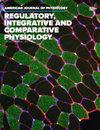Is there a golden hour for exercise in aging females? A perspective on the female-specific effects of estradiol in regulating vascular endothelial function.
IF 2.3
3区 医学
Q3 PHYSIOLOGY
American journal of physiology. Regulatory, integrative and comparative physiology
Pub Date : 2025-07-01
Epub Date: 2025-05-17
DOI:10.1152/ajpregu.00163.2024
引用次数: 0
上了年纪的女性有锻炼的黄金时间吗?雌二醇在调节血管内皮功能中的女性特异性作用研究进展。
性激素在生殖健康中的作用是众所周知的;然而,它们对非生殖组织(如脉管系统)产生辅助作用,特别是涉及内皮血管舒张和血管收缩的调解。绝经过渡期雌激素的突然下降与内皮功能障碍和随后心血管事件的增加有关。毫不奇怪,参与体育活动和锻炼被推荐为增强内皮功能的常见策略,不同运动方式对血管健康结果和风险调节的有效性已被广泛研究。然而,尽管人们意识到绝经期间和绝经后心血管疾病(CVD)风险增加,但在这一关键时期,围绕运动作为增强女性内皮功能的手段的有效性,存在相互矛盾的证据。这篇前瞻性文章旨在讨论雌二醇对女性内皮功能影响的现有证据,以及是否有可能通过在围绝经期进行干预,在育龄后期进行运动,从而获得更大的血管益处。
本文章由计算机程序翻译,如有差异,请以英文原文为准。
求助全文
约1分钟内获得全文
求助全文
来源期刊
CiteScore
5.30
自引率
3.60%
发文量
145
审稿时长
2 months
期刊介绍:
The American Journal of Physiology-Regulatory, Integrative and Comparative Physiology publishes original investigations that illuminate normal or abnormal regulation and integration of physiological mechanisms at all levels of biological organization, ranging from molecules to humans, including clinical investigations. Major areas of emphasis include regulation in genetically modified animals; model organisms; development and tissue plasticity; neurohumoral control of circulation and hypertension; local control of circulation; cardiac and renal integration; thirst and volume, electrolyte homeostasis; glucose homeostasis and energy balance; appetite and obesity; inflammation and cytokines; integrative physiology of pregnancy-parturition-lactation; and thermoregulation and adaptations to exercise and environmental stress.

 求助内容:
求助内容: 应助结果提醒方式:
应助结果提醒方式:


